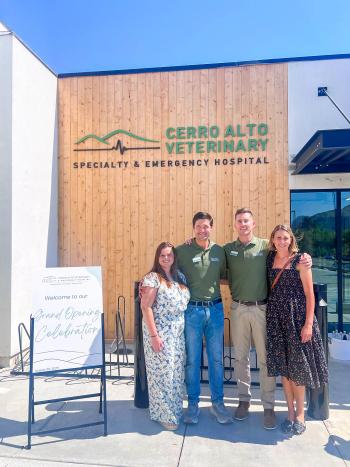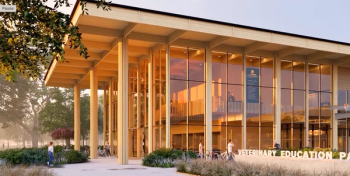
Building a legacy of quality care
The expanding family of veterinarians at Shenandoah Veterinary Hospital in Martinsburg, W.Va., found much-needed space in a new 8,000-square-foot hospital-and continued their father's quality of care.
If three’s a crowd, the team at Shenandoah Veterinary Hospital in Martinsburg, W.Va., had quite the gathering going on. With three owner veterinarians, four associates, and a full support staff, this team was exercising creativity to the fullest just to survive in its original three-exam-room hospital.
Built in 1974 by Dr. K.W. Gilpin, the facility was showing its age. Dr. Gilpin’s sons, Drs. Darin and Brian Gilpin, joined the practice as co-owners in the ’90s and continued to grow the practice. While they loved the structure their father had built from the ground up, they knew it needed a facelift. They also needed considerably more space.
“The old facility had a really good flow to it,” Dr. Darin Gilpin says. “But we’d maximized every inch of space. We were stepping all over each other. Thankfully, Dad was very supportive of this move and liked the ideas my brother and I had. Really, we used many of his design ideas from the old building, just in a larger space.”
Apparently Dr. K. W. Gilpin had some good ideas 35 years ago. By expanding and improving on his original design, Shenandoah Veterinary Hospital won a Merit Award in the 2011 Veterinary Economics Hospital Design Competition.
To build or not to build
Originally, the doctors considered remodeling and adding on to the practice’s existing facility. After meeting with architects at the Veterinary Economics Hospital Design Conference in Kansas City, they realized the need for a feasibility study to make the best use of their money and space. The results of that study convinced the Gilpins to build new. Fortunately they were able to buy the adjoining land, build right next door, and keep their old building for future boarding space.
Next they had to decide what type of architect group to employ. The Gilpins had local builder friends they strongly considered using, but they also liked the idea of a design-build group, where one team manages both the design and construction phases of the project.
“In the end, we realized that veterinary hospitals are unique, and we decided that a veterinary-specific design-build company made the most sense for us,” Dr. Darin Gilpin says. “While it was difficult not to hire our friends, we felt this was the best route for us.” The doctors did hire many local contractors and in doing so contributed jobs to their community, and they say in the end they were thrilled with their decision.”
Photos by Jamie Turner, Turner Photography Studio
Getting a feel for flow
A beautiful hospital is great, but flow is most important, Dr. Darin Gilpin says. “We wanted something we could practice in for the next 20 to 30 years and not worry about expanding or changing much,” he says. “However, we didn’t want too large of a place, or anything ostentatious.” Their architect guided the process by having the owners fill out a questionnaire outlining how they and the staff used the practice, how many exam rooms they wanted, and what their other “must-haves” were.
The shape of the land significantly determined the general design of the practice. The doctors wanted a linear exam room layout, and clients had requested separate entry doors into the exam rooms, one for clients and one for doctors and staff. “While we wanted to accommodate that, space limitations only allowed us to install two doors on four of the exam rooms,” Dr. Darin Gilpin says. The rest of the exam rooms have one door, but they’re separated from view of the reception area by a hallway door, offering privacy to both waiting clients and those in the exam rooms. No two exam rooms are identical, with varying shapes, sizes, table types, and configurations. “This really worked out best for us, making great use of our space and offering unique settings for our patients and clients,” he says.
In addition to a more comfortable and efficient layout, the doctors have also upgraded all of their lab equipment and now offer digital dental radiography. Dr. Darin Gilpin estimates that the practice performs about 60 percent of its labwork in-house. “The newer machines did have a slight learning curve, but we transitioned smoothly and are more efficient,” he says.
Minor growing pains
In this down economy, the Gilpins have yet to see a major boost in numbers resulting from their new building. “We’re seeing a slight increase from year to year, but the growth wasn’t nearly what we expected,” Dr. Darin Gilpin says. “We bought our land when property values were at their all-time high. We were too far along to quit when the finances turned sour. Besides, we really needed the space, so we continued on, and we’re glad we did. Clients are thrilled with the new facility, and we know it will pay off in the long run.”
While the owners built large enough to last many years, they aren’t completely done with construction yet. They plan to remodel the old facility to house a new boarding space once the economy allows them to do so. “We’re hopeful that the economy will turn around soon, but for now we’re using the space mostly for storage and a bit of boarding in the existing space,” Dr. Darin Gilpin says.
Shenandoah Veterinary Hospital
1152 Shepherdstown Road
Martinsburg, WV 25404
(304) 263-2112
Owner: Drs. K. W. Gilpin, Darin Gilpin, Brian Gilpin
Associates: 3 full time, 1 part time
Hospital team: 15 full time, 7 part time
Practice type: 100 percent small animal
Building size: 8,094 square feet
Exam rooms: 10
Runs: 8 hospital indoor
Cages: 57
Parking spaces: 30 client, 32 staff
Construction: $1.5 million (building only; excludes land purchase, landscaping, parking lot, etc.)
Land purchase: $465,000
Site improvement: $285,000
Professional fees: $260,822
Equipment: $277,154
Furnishings: $23,980
Computers: $23,000
Year built: 2009
Architect
Wayne Usiak and Wendy Wheeler Martinez
BDA Architecture P.C.
901 Lamberton Place NE
Albuquerque, NM 87107
(505) 858-0180
Reception
Comfort and convenience: The light and airy reception area features separate check-in and checkout areas, bench seating, vaulted ceilings, and an abundance of windows.
Exam room
Making it work: Four exam rooms have two doors, per client request. Space required the remainder of the rooms to have only one door, but Dr. Darin Gilpin says this is working fine
Treatment
Elbow room: Doctors and team members love the large treatment room with more work space. Four workstations give staff members plenty of room to move.
Signage
Sign of the times: The large, easy-to read sign makes the hospital easy to spot.
Newsletter
From exam room tips to practice management insights, get trusted veterinary news delivered straight to your inbox—subscribe to dvm360.






